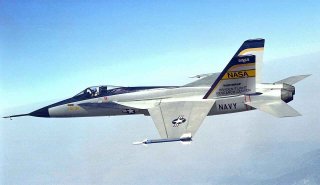America’s fourth-generation warplane fleet is the most iconic and probably the greatest fleet of warplanes ever devised. Indeed, during the development phase of these multiple classes of warplanes, even more were experimented with that never made it beyond the test phase. One of the most interesting planes developed during America’s fourth-generation warplane development craze was the Northrop YF-17 “Cobra.”
Designed to be a lightweight fighter aircraft, the YF-17 was launched by the United States Air Force to counter the dangerous trend of increasingly sophisticated and, therefore, very expensive warplanes. The goal of the project was simple. Northrop wanted to build an agile, cost-effective warplane that could complement existing fourth-generation birds, such as the F-15 Eagle.
The YF-17 was a sleek warplane that looked like a miniature F-15.
The Specs
Powered by two General Electric YJ101-GE-100 afterburning engines that brought this forgotten plane to a top speed of Mach 1.95, YF-17 was meant for high maneuverability. Sporting features like leading-edge root extensions (LERX), which enhanced the lift and stability of her angles of attack, had this plane ever entered combat against the Soviet Air Force, America’s primary geopolitical enemy of the day, the Cobra would have been lethal in tight spots.
Constructed of primarily of aluminum, Northrop threw in some composite materials to reduce the overall weight of the craft while ensuring its strength.
YF-17 included many features that were unique for its time but would eventually become part of future warplane models in America’s fleet. Things like a bubble canopy for better visibility and a heads-up display (HUD) were still rare to find in many planes of its era. Ultimately, though, the popularity of many of the ideas undergirding the YF-17 Cobra would long outlive the YF-17 itself.
Northrop’s YF-17 was placed into a head-to-head competition with General Dynamics’ YF-16 under the Lightweight Fighter (LWF) Program. During the trials, the Air Force noted that the YF-17 demonstrated superior performance and handling than its General Dynamics competitor. Yet, the Air Force inevitably concluded that the maintenance and operational costs would be lower for the YF-16 than the Cobra.
What’s more, the YF-16 had greater range and, despite the YF-17 being created specifically to provide the pilot with greater maneuverability than other fourth-generation birds at the time, the Air Force assessed that the YF-16 had greater maneuverability.
Thus, the Air Force opted to purchase General Dynamics’ YF-16 that ultimately became the F-16 Falcon, which is likely the greatest warplane in the Air Force’s arsenal (even though the F-22A Raptor is technologically superior to the F-16, the Falcon has a longer service record and holds a special place in the hearts of most Airmen).
The Inspiration for the F/A-18 Hornet
Interestingly, shortly after it was canceled by the Air Force, the Navy expressed interest in procuring the YF-17 Cobra. So, it became part of the Naval Fighter Attack Experimental (VFAX) Program.
Navy designers modified the Cobra to better meet Navy requirements (notably ensuring that these planes could realistically handle the unique challenges of deployments aboard aircraft carriers).
But the Navy did not use the YF-17 as anything more than an inspiration for the design and development of the F/A-18 Hornet. It was the Hornet, not the Cobra, that rose to replace the aging F-14 Tomcat and A-7 Corsair II warplanes that were assigned to the fleet.
The F/A-18 Hornet’s success as the primary warplane for decades for the US Navy, though, was only made possible because of the lessons the Navy learned from studying and operating the YF-17 during the testing phase of the VFAX program.
An Incredible, Forgotten Plane
It is obvious that the YF-17 is the foundation of the F/A-18, and all its subsequent variants, ensuring the F/A-18 was such a popular and dominant platform for the Navy all these years.
In short, the YF-17 Cobra may be the most important American warplane you’ve never heard of. Its unique engineering and design, coupled with the new capabilities both the Air Force and Navy had worked into this bird, became standard for many subsequent warplane models. It is possible that, without the YF-17 having been built, none of the great warplanes of our era would have been built like they were.
It’s just too bad that we did not get at least a squadron of these beauties in either the Air Force or the Navy.
Brandon J. Weichert, a Senior National Security Editor at The National Interest as well as a Senior Fellow at the Center for the National Interest, and a contributor at Popular Mechanics, consults regularly with various government institutions and private organizations on geopolitical issues. Weichert’s writings have appeared in multiple publications, including the Washington Times, National Review, The American Spectator, MSN, the Asia Times, and countless others. His books include Winning Space: How America Remains a Superpower, Biohacked: China’s Race to Control Life, and The Shadow War: Iran’s Quest for Supremacy. His newest book, A Disaster of Our Own Making: How the West Lost Ukraine is available for purchase wherever books are sold. He can be followed via Twitter @WeTheBrandon.
Image: Wikimedia Commons.

